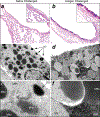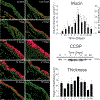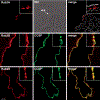Mucin is produced by clara cells in the proximal airways of antigen-challenged mice
- PMID: 15191915
- PMCID: PMC10862391
- DOI: 10.1165/rcmb.2004-0060OC
Mucin is produced by clara cells in the proximal airways of antigen-challenged mice
Abstract
Airway mucus hypersecretion is a prominent feature of many obstructive lung diseases. We thus determined the ontogeny and exocytic phenotype of mouse airway mucous cells. In naive mice, ciliated (approximately 40%) and nonciliated (approximately 60%) epithelial cells line the airways, and > 95% of the nonciliated cells are Clara cells that contain Clara cell secretory protein (CCSP). Mucous cells comprise < 5% of the nonciliated cells. After sensitization and a single aerosol antigen challenge, alcian blue-periodic acid Schiff's positive mucous cell numbers increase dramatically, appearing 6 h after challenge (21% of nonciliated/nonbasal cells), peaking from Days 1-7 (99%), and persisting at Day 28 (65%). Throughout the induction and resolution of mucous metaplasia, ciliated and Clara cell numbers identified immunohistochemically change only slightly. Intracellular mucin content peaks at Day 7, and mucin expression is limited specifically to a Clara cell subset in airway generations 2-4 that continue to express CCSP. Functionally, Clara cells are secretory cells that express the regulated exocytic marker Rab3D and, in antigen-challenged mice, rapidly secrete mucin in response to inhaled ATP in a dose-dependent manner. Thus, Clara cells show great plasticity in structure and secretory products, yet have molecular and functional continuity in their identity as specialized apical secretory cells.
Figures








Similar articles
-
Munc13-2-/- baseline secretion defect reveals source of oligomeric mucins in mouse airways.J Physiol. 2008 Apr 1;586(7):1977-92. doi: 10.1113/jphysiol.2007.149310. Epub 2008 Feb 7. J Physiol. 2008. PMID: 18258655 Free PMC article.
-
Clara cell secretory protein deficiency alters clara cell secretory apparatus and the protein composition of airway lining fluid.Am J Respir Cell Mol Biol. 2002 Aug;27(2):170-8. doi: 10.1165/ajrcmb.27.2.200200270c. Am J Respir Cell Mol Biol. 2002. PMID: 12151308
-
Distribution of nonciliated bronchiolar epithelial (Clara) cells in intra- and extrapulmonary airways of the rabbit.Exp Lung Res. 1983 Sep;5(2):79-98. doi: 10.3109/01902148309061506. Exp Lung Res. 1983. PMID: 6628348
-
[Clara cell secretion protein].Sheng Li Ke Xue Jin Zhan. 2003 Jul;34(3):227-30. Sheng Li Ke Xue Jin Zhan. 2003. PMID: 14628468 Review. Chinese. No abstract available.
-
Airway Mucin Secretion.Ann Am Thorac Soc. 2018 Nov;15(Suppl 3):S164-S170. doi: 10.1513/AnnalsATS.201806-371AW. Ann Am Thorac Soc. 2018. PMID: 30431339 Free PMC article. Review.
Cited by
-
Baseline Goblet Cell Mucin Secretion in the Airways Exceeds Stimulated Secretion over Extended Time Periods, and Is Sensitive to Shear Stress and Intracellular Mucin Stores.PLoS One. 2015 May 29;10(5):e0127267. doi: 10.1371/journal.pone.0127267. eCollection 2015. PLoS One. 2015. PMID: 26024524 Free PMC article.
-
Immunogenetic programs for viral induction of mucous cell metaplasia.Am J Respir Cell Mol Biol. 2006 Jul;35(1):29-39. doi: 10.1165/rcmb.2006-0092SF. Epub 2006 Mar 16. Am J Respir Cell Mol Biol. 2006. PMID: 16543602 Free PMC article. Review. No abstract available.
-
An update in club cell biology and its potential relevance to chronic obstructive pulmonary disease.Am J Physiol Lung Cell Mol Physiol. 2023 May 1;324(5):L652-L665. doi: 10.1152/ajplung.00192.2022. Epub 2023 Mar 21. Am J Physiol Lung Cell Mol Physiol. 2023. PMID: 36942863 Free PMC article. Review.
-
Regulation of mucous cell metaplasia in bronchial asthma.Curr Mol Med. 2008 Aug;8(5):408-15. doi: 10.2174/156652408785160961. Curr Mol Med. 2008. PMID: 18691068 Free PMC article. Review.
-
Murine CLCA5 is uniquely expressed in distinct niches of airway epithelial cells.Histochem Cell Biol. 2015 Mar;143(3):277-87. doi: 10.1007/s00418-014-1279-x. Epub 2014 Sep 12. Histochem Cell Biol. 2015. PMID: 25212661 Free PMC article.
References
-
- Hogg JC, MACKLEM PT, and Thurlbeck WM Site and Nature of Airway Obstruction in Chronic Obstructive Lung Disease. New England Journal of Medicine 1968;20;278(25):1355–60. - PubMed
-
- Huber HL and Koessler KK The Pathology of Bronchial Asthma. Arch Intern Med 1922;30:689–760.
-
- Bedrossian CW, Greenberg SD, Singer DB, Hansen JJ, and Rosenberg HS The Lung in Cystic Fibrosis. A Quantitative Study Including Prevalence of Pathologic Findings Among Different Age Groups. Hum.Pathol. 1976;7(2):195–204. - PubMed
-
- Sethi S, Evans N, Grant BJ, and Murphy TF New Strains of Bacteria and Exacerbations of Chronic Obstructive Pulmonary Disease. New England Journal of Medicine August-15-2002;347(7):465–71. - PubMed
Publication types
MeSH terms
Substances
Grants and funding
LinkOut - more resources
Full Text Sources
Other Literature Sources

